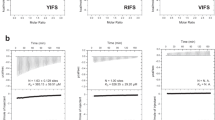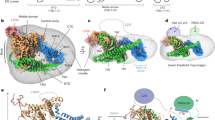Abstract
Hrs has an essential role in sorting of monoubiquitinated receptors to multivesicular bodies for lysosomal degradation, through recognition of ubiquitinated receptors by its ubiquitin-interacting motif (UIM). Here, we present the structure of a complex of Hrs-UIM and ubiquitin at 1.7-Å resolution. Hrs-UIM forms a single α-helix, which binds two ubiquitin molecules, one on either side. These two ubiquitin molecules are related by pseudo two-fold screw symmetry along the helical axis of the UIM, corresponding to a shift by two residues on the UIM helix. Both ubiquitin molecules interact with the UIM in the same manner, using the Ile44 surface, with equal binding affinities. Mutational experiments show that both binding sites of Hrs-UIM are required for efficient degradative protein sorting. Hrs-UIM belongs to a new subclass of double-sided UIMs, in contrast to its yeast homolog Vps27p, which has two tandem single-sided UIMs.
This is a preview of subscription content, access via your institution
Access options
Subscribe to this journal
Receive 12 print issues and online access
$189.00 per year
only $15.75 per issue
Buy this article
- Purchase on Springer Link
- Instant access to full article PDF
Prices may be subject to local taxes which are calculated during checkout





Similar content being viewed by others
References
Di Fiore, P.P., Polo, S. & Hofmann, K. When ubiquitin meets ubiquitin receptors: a signalling connection. Nat. Rev. Mol. Cell Biol. 4, 491–497 (2003).
Schnell, J.D. & Hicke, L. Non-traditional functions of ubiquitin and ubiquitin-binding proteins. J. Biol. Chem. 278, 35857–35860 (2003).
Swanson, K.A., Kang, R.S., Stamenova, S.D., Hicke, L. & Radhakrishnan, I. Solution structure of Vps27 UIM-ubiquitin complex important for endosomal sorting and receptor downregulation. EMBO J. 22, 4597–4606 (2003).
Kang, R.S. et al. Solution structure of a CUE-ubiquitin complex reveals a conserved mode of ubiquitin binding. Cell 113, 621–630 (2003).
Alam, S.L. et al. Ubiquitin interactions of NZF zinc fingers. EMBO J. 23, 1411–1421 (2004).
Ohno, A. et al. Structure of the UBA domain of Dsk2p in complex with ubiquitin: molecular determinants for ubiquitin recognition. Structure 13, 521–532 (2005).
Teo, H., Veprintsev, D.B. & Williams, R.L. Structural insights into endosomal sorting complex required for transport (ESCRT-I) recognition of ubiquitinated proteins. J. Biol. Chem. 279, 28689–28696 (2004).
Sundquist, W.I. et al. Ubiquitin recognition by the human TSG101 protein. Mol. Cell 13, 783–789 (2004).
Wang, Q., Young, P. & Walters, K.J. Structure of S5a bound to monoubiquitin provides a model for polyubiquitin recognition. J. Mol. Biol. 348, 727–739 (2005).
Mueller, T.D. & Feigon, J. Structural determinants for the binding of ubiquitin-like domains to the proteasome. EMBO J. 22, 4634–4645 (2003).
Fujiwara, K. et al. Structure of the ubiquitin-interacting motif of S5a bound to the ubiquitin-like domain of HR23B. J. Biol. Chem. 279, 4760–4767 (2004).
Kawasaki, M. et al. Molecular mechanism of ubiquitin recognition by GGA3 GAT domain. Genes Cells 10, 639–654 (2005).
Fisher, R.D. et al. Structure and ubiquitin binding of the ubiquitin-interacting motif. J. Biol. Chem. 278, 28976–28984 (2003).
Raiborg, C. & Stenmark, H. Hrs and endocytic sorting of ubiquitinated membrane proteins. Cell Struct. Funct. 27, 403–408 (2002).
Raiborg, C., Rusten, T.E. & Stenmark, H. Protein sorting into multivesicular endosomes. Curr. Opin. Cell Biol. 15, 446–455 (2003).
Raiborg, C. et al. Hrs sorts ubiquitinated proteins into clathrin-coated microdomains of early endosomes. Nat. Cell Biol. 4, 394–398 (2002).
Shih, S.C. et al. Epsins and Vps27p/Hrs contain ubiquitin-binding domains that function in receptor endocytosis. Nat. Cell Biol. 4, 389–393 (2002).
Prag, G. et al. Mechanism of ubiquitin recognition by the CUE domain of Vps9p. Cell 113, 609–620 (2003).
Polo, S. et al. A single motif responsible for ubiquitin recognition and monoubiquitination in endocytic proteins. Nature 416, 451–455 (2002).
Shekhtman, A. & Cowburn, D. A ubiquitin-interacting motif from Hrs binds to and occludes the ubiquitin surface necessary for polyubiquitination in monoubiquitinated proteins. Biochem. Biophys. Res. Commun. 296, 1222–1227 (2002).
Hofmann, K. & Falquet, L. A ubiquitin-interacting motif conserved in components of the proteasomal and lysosomal protein degradation systems. Trends Biochem. Sci. 26, 347–350 (2001).
Sugiyama, S., Kishida, S., Chayama, K., Koyama, S. & Kikuchi, A. Ubiquitin-interacting motifs of Epsin are involved in the regulation of insulin-dependent endocytosis. J. Biochem. 137, 355–364 (2005).
Otwinowski, Z. & Minor, W. Processing of X-ray diffraction data collected in oscillation mode. Methods Enzymol. 276, 307–326 (1997).
Collaborative Computational Project, Number 4. The CCP4 suite: programs for protein crystallography. Acta Crystallogr D Biol. Crystallogr. 50, 760–763 (1994).
Brünger, A.T. et al. Crystallography & NMR system: a new software for macromolecular structure determination. Acta Crystallogr. D Biol. Crystallogr. 54, 905–921 (1998).
Roussel, A. & Cambilleau, C. Turbo-Frodo. in Silicon Graphics Geometry, Partners Directory 77–79 (Silicon Graphics, Mountain View, California, USA, 1989).
Kraulis, P.J. MOLSCRIPT: a program to produce both detailed and schematic plots of protein structures. J. Appl. Crystallogr. 24, 946–950 (1991).
Merritt, E.A. & Murphy, M.E. Raster3D Version 2.0. A program for photorealistic molecular graphics. Acta Crystallogr. D Biol. Crystallogr. 50, 869–873 (1994).
Nicholls, A., Sharp, K.A. & Honig, B. Protein folding and association: insights from the interfacial and thermodynamic properties of hydrocarbons. Proteins Struct. Funct. Genet. 11, 281–296 (1991).
Bache, K.G., Raiborg, C., Mehlum, A. & Stenmark, H. STAM and Hrs are subunits of a multivalent ubiquitin-binding complex on early endosomes. J. Biol. Chem. 278, 12513–12521 (2003).
Raiborg, C., Bache, K.G., Mehlum, A., Stang, E. & Stenmark, H. Hrs recruits clathrin to early endosomes. EMBO J. 20, 5008–5021 (2001).
Acknowledgements
This work was supported in part by the Protein 3000 project and by Grants-in-Aid from the Ministry of Education, Culture, Sports, Science and Technology of Japan, as well as by the Norwegian Cancer Society, the Research Council of Norway and the Novo-Nordisk Foundation.
Author information
Authors and Affiliations
Corresponding author
Ethics declarations
Competing interests
The authors declare no competing financial interests.
Supplementary information
Supplementary Table 1
Sequences of synthesized DNA fragments for GST-UIM (PDF 9 kb)
Supplementary Table 2
Sequences of QuikChange primers for UIM mutants (PDF 14 kb)
Rights and permissions
About this article
Cite this article
Hirano, S., Kawasaki, M., Ura, H. et al. Double-sided ubiquitin binding of Hrs-UIM in endosomal protein sorting. Nat Struct Mol Biol 13, 272–277 (2006). https://doi.org/10.1038/nsmb1051
Received:
Accepted:
Published:
Issue Date:
DOI: https://doi.org/10.1038/nsmb1051
This article is cited by
-
HRS phosphorylation drives immunosuppressive exosome secretion and restricts CD8+ T-cell infiltration into tumors
Nature Communications (2022)
-
Viral journeys on the intracellular highways
Cellular and Molecular Life Sciences (2018)
-
Tandem UIMs confer Lys48 ubiquitin chain substrate preference to deubiquitinase USP25
Scientific Reports (2017)
-
A bacterial genetic selection system for ubiquitylation cascade discovery
Nature Methods (2016)
-
Jarid2 binds mono-ubiquitylated H2A lysine 119 to mediate crosstalk between Polycomb complexes PRC1 and PRC2
Nature Communications (2016)



